James R. Callan's Blog, page 20
June 26, 2015
My Dad, the Hippie
Ann Lee Miller earned a BA in creative writing from Ashland (Ohio)  University and writes full-time in Phoenix, Arizona, but left her heart in Florida, where she grew up on a sailboat. She loves speaking to young adults and guest lectures on writing at several Arizona colleges. Over 100,000 copies of her debut novel, Kicking Eternity, have been downloaded from Amazon. She blogs memoir at AnnLeeMiller.com. Here is a memoir article about growing up on a sailboat.
University and writes full-time in Phoenix, Arizona, but left her heart in Florida, where she grew up on a sailboat. She loves speaking to young adults and guest lectures on writing at several Arizona colleges. Over 100,000 copies of her debut novel, Kicking Eternity, have been downloaded from Amazon. She blogs memoir at AnnLeeMiller.com. Here is a memoir article about growing up on a sailboat.
Hurricane Laurie gusted across the Gulf of Mexico, 105 mile-an-hour winds gunned for the Glades and south Florida. It was October 27, 1969, and my family barreled across Biscayne Bay under full sail, heading for a Hurricane Hole to wait out the storm.
I planted my eleven-year-old self on the foredeck, scanning the distant shoreline for a gap that might be our cove. .
I was not afraid. Dad would keep us safe.
But his tension bled into me.
Sailing was supposed to soothe, but even under clear skies, Dad stressed.
He could have taken a lesson from the hippies he admired. They rattled around Coconut Grove in beater Volkswagen vans, on bikes or on foot—wafting Patchouli oil, incense, and I-don’t-care in their wake. They didn’t care about jobs, haircuts, or monogamy. They ingested bean sprouts by the pound, brownies when they got the munchies. The women burned their bras.
I glanced back at the cockpit.
At the helm, Dad stood ram-rod in his crew cut. Mom posed at his side, her nurse’s uniform tented to symmetrical cones by a sturdy bra. They were a hip American Gothic portrait of monogamy.
We were coming up fast on a buoy. I shouted to Dad and pointed.
Dad levered the tiller hard to starboard, and the boat swerved and came about. He yelled, “What color is the damn buoy?” the second I remembered he was colorblind.
“Red!” Mom shouted.
He angled the boat into the wind and we drifted past the buoy.
Dad raised his voice over the flapping of the sails. “Annie, check our depth!”
I scrambled over the main cabin, readying for the thud of our keel hitting bottom.
Rigging clanged against the aluminum mast.
My fingers closed around the depth-sounder, a long mop handle with notches carved at one-foot intervals.
Patches of sand blinked through the seaweed below us, but we still floated.
Dad angled us back into the channel.
The sails filled.
I let the pole roll from my fingers, releasing a breath I didn’t know I’d been holding.
My five-year-old brother crouched in the corner of the cockpit, wide-eyed. These were the best days of his life, he’d tell me later.
Dad white-knuckled the tiller, his calming yoga work-outs not paying off. He’d lift his body off the dock with his hands and levitate his legs front or spread right and left. He did handstands while we kids counted the seconds. He sat Indian style with both heels up—like a hippie doing Transcendental Meditation.
I think Dad secretly wanted to be a hippie. But everyone knew flower children were young. Dad had rounded forty and was riding a Boston Whaler full-throttle toward forty-five.
 But no hippie would coat his kids’ noses, cheeks, and shoulders in zinc oxide twenty-four-seven—when the rest of the world was frying itself in Johnson’s Baby Oil. Hippie dads wouldn’t make their kids check in every hour. They wouldn’t saddle their offspring with chores like painting a stretch of deck or stacking lumber in the aft cabin.
But no hippie would coat his kids’ noses, cheeks, and shoulders in zinc oxide twenty-four-seven—when the rest of the world was frying itself in Johnson’s Baby Oil. Hippie dads wouldn’t make their kids check in every hour. They wouldn’t saddle their offspring with chores like painting a stretch of deck or stacking lumber in the aft cabin.
A hippie dad would be too stoned to make his kid read aloud Euell Gibbons’ Stalking the Blue-Eyed Scallop and phonetically sound out all the fifty-gallon words.
My stomach growled as my eyes swept across the seawall looking for an opening. I wondered if there was anything to eat on board that hadn’t lived in the bay. The beansprouts Dad grew in the cupboard didn’t count.
He ground conch in a hand-cranked meat grinder into chowder and fritters that had to be chewed twenty-five times and tasted like rubber hose. Clams were dug at low tide. We scooped shrimp—when they ran—in nets from the dock. Dad gigged, cast-netted, spear-fished our food. Once in a while he poached a Florida ‘lobster’ by reaching into a crawfish hole, ripping off its tail, and stuffing it into his trunks. He never got caught.
Dad hollered for me to take down the foresail.
While I worked, my brother manned the tiller, Dad downed the mizzen sail, and Mom—binoculars to her eyes— yelled, “There’s the inlet!”
Relief flooded through me, and the wind gentled as we closed in on the shore.
I needed to think about something other than food.
JIM: That’s all we have room for today. But, Ann will finish the article next week, so be sure and come back. In the meantime, you can view her book Kicking Eternity by clicking here.
June 19, 2015
I Am My Words
Today’s guest is Grady Jane Woodfin, who just finished her BFA in Creative Writing for Entertainment. She’s been published in several literary magazines such as Crab Fat and ThickJam, and her short story “Twizzlers,” was a 2015 Pushcart Prize nominee. Today, she talks about why we should write about what we know. Here are her words.
Creative Writing for Entertainment. She’s been published in several literary magazines such as Crab Fat and ThickJam, and her short story “Twizzlers,” was a 2015 Pushcart Prize nominee. Today, she talks about why we should write about what we know. Here are her words.
Writing is a lonely job. I can talk story and characters and plot and themes and genres all day long, but when it comes down to it, it’s just me and a terrifying white, blank page with an annoying cursor that counts the seconds with its blinks. But before I can confront that white, blank page, I have to face a different monster all together.
What do I write about?
My entire writing career, people have always told me, “Grady, write about what you know.”
“What do you mean?” I ask.
“I mean write about what you know.”
“But what if I don’t know much of anything.”
“Then you probably shouldn’t be a writer.”
So, what do I know? Well, I know some things. You see, I am constantly wondering if anyone else in the world has ever felt the way I’m feeling. That’s a huge part of what draws me into writing. I’m convinced a lot of my writing is desperately trying to work things out in my own head.
I find myself crafting stories that have strong undertones of the struggles I face in every day life. In my short story, Twizzlers, I focused on writing about things like loneliness, abandonment, family, and starting over. These were vital for me to tell a good story because they were conflicts I’d experienced before. I was battling my demons in my own stories.
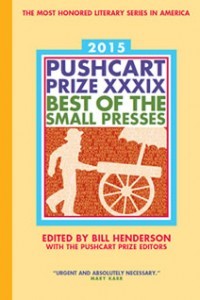 So far, I find this to be true with other writers. We all seem to be writing about what we know best, whether it’s loss or love, revenge or redemption. I think we do it without thinking. It’s our natural, default setting. It’s almost guaranteed that if something is keeping a writer up at night, they’re going to express one way or another through their writing, whether it’s the A story plot or an obscure sub-plot that’s mentioned in half of a sentence on page 187 of the second draft. We’re all writing about what we know because it’s familiar to us.
So far, I find this to be true with other writers. We all seem to be writing about what we know best, whether it’s loss or love, revenge or redemption. I think we do it without thinking. It’s our natural, default setting. It’s almost guaranteed that if something is keeping a writer up at night, they’re going to express one way or another through their writing, whether it’s the A story plot or an obscure sub-plot that’s mentioned in half of a sentence on page 187 of the second draft. We’re all writing about what we know because it’s familiar to us.
But there’s something horrifying that comes with admitting I’m really writing about my own experiences. Writing about what I know makes me vulnerable. As Ernest Hemingway once said, “There is nothing to writing. All you do is sit down at a typewriter and bleed.” Writing is literally transferring myself onto a piece of paper and hoping that someone, somewhere is going to relate to the obstacles I’ve overcome… or maybe didn’t overcome. There’s nothing separates the writer and the reader. There is nothing on the paper but black and white truth. Brutal and honest and messy truths.
I am my words.
That’s the scariest part.
Writing sounds like an awful labor of love. I write because I exist. I exist because I write. So on and so forth. The cycle continues. However, there is a light at the end of the tunnel.
There’s a reason I write about what I know. I write about what I know because what I know is real. It’s conflict that I’ve encountered. It’s problems that have haunted my nights and trickled into my days.
It is the realness of writing about what I know that makes my storytelling relatable.
When characters encounter a realistic problem the reader has also faced. That’s the exact moment that makes all the vulnerability of writing payoff because something clicks, and somebody says, “Hey, I never knew that someone else in the world had felt that way before. I thought I was the only one, and it’s nice to know that I’m not.”
Writing about what haunts me most, deep down in my gut may be alarming, but without that twinge of helplessness, writing wouldn’t be nearly as rewarding.
Always write about what you know because it’s those stories that mean the most.
JIM: Grady Jane’s immediate plans are to move to LA and break into the television writing industry. Here are some links to find out more about this young writer.
Her website/portfolio: http://www.gradyjanewoodfin.com/
Twitter: https://twitter.com/GradyJWoodfin
Tumblr: http://gradyjanewrites.tumblr.com/
Facebook: https://www.facebook.com/grady.woodfin
June 12, 2015
Nine Ways to Get More Book Reviews
Today I am pleased to have Misty M. Beller on board. She shares  with us some great tips on that all important task for writers – how to get more reviews for our books. So, I not going to delay that even a minute. Let heard what she has to suggest.
with us some great tips on that all important task for writers – how to get more reviews for our books. So, I not going to delay that even a minute. Let heard what she has to suggest.
Word of mouth is what sells books, right? The Amazon review is one of the most powerful word-of-mouth tools you’ll ever encounter. Is your book well-researched? Your readers will appreciate that and mention it in their reviews. Did you forget to tie up loose ends in your story line? You’ll be called out on it, I guarantee. Potential readers often look at the reviews to see if they’re willing to spend precious money and time to read your story. Hone your craft and write the best story possible, and your reviews will reflect it.
How many reviews do you need? Many writers say it seems there’s something “magical” about reaching twenty-five. After that, they seem to come so much easier and quicker. The more reviews you have with a four- or five-star rating, the more comfortable a potential reader will be taking a chance on your book.
So let’s take an extra minute to talk through methods for garnering reviews.
Many of the options in this list work best if you send out ebook files, but you may sometimes need to send hard copies. Not every method works for every person or book, so it’s great that we have so many options!
Friends and family: Most of them are eager to post a review when they learn it will help you.
Critique Partners and Beta Readers: They’ve already read the book, so it should be an easy review.
Launch team: This is something I started with my second book and have enjoyed! Right now I have a group of twelve on my team, but I have an open sign-up form on my website where energetic leaders can request to join the team. The main thing I ask from my launch team is to post reviews. Anything else is optional!
In the back matter of your book (I put this immediately following the last page of the story), have a page that asks the reader to post a review if they enjoyed the book. Have a clickable link (in your ebook) that takes them directly to the review page.
Pre-orders. This is one of my personal favorites and one of the main ways I got my first 30ish reviews on The Lady and The Mountain Doctor . I wrote a fairly extensive blog post on pre-orders here .
Ask other authors if they would be willing to read and review. The upside is authors do understand the value of reviews. The downside is most authors have a To Be Read stack taller than they are.
Facebook groups like Christian Reviewers where you can post your book to potential reviewers. If they’re interested, you email the person an ebook and they post a review. I’ve heard good things about these groups, however most will only let you post a book to the site if it has less than 10 reviews.
Websites like StoryCartel.com, literatiauthorservices.com and others where you can post your book to potential reviewers. If they’re interested, you send them an ebook through the website and they post a review. General feedback I’ve heard from this site is you usually get review on about 10-30% of the books you send.
Free days. This is much harder to pull off if you’re traditionally published, but basically you lower your ebook price to free for a day or two (or five). You’ll typically receive thousands of downloads each day for a free book. If you have a note in the back matter of your book asking satisfied readers to post a review, those thousands of free downloads result in lots of reviews. You also have the nice side effect of great ranking with Amazon during those free days, which creates VISIBILITY and can help increase sales numbers once you’re back to regular price.
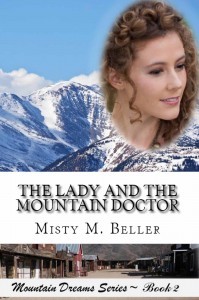 Now, I’d love to hear from you! Have you found any of these options to be successful? Are there other strategies you use that aren’t listed here? Let’s hear them!
Now, I’d love to hear from you! Have you found any of these options to be successful? Are there other strategies you use that aren’t listed here? Let’s hear them!
You can find her on her website, reader blog, marketing blog for authors, Goodreads, Twitter, Google+, and Pinterest. Or check out her books The Lady and the Mountain Man or The Lady and the Mountain Doctor.
June 5, 2015
The Long Tail in Publishing
Today, Stephen Woodfin talks about the new paradigm for writers, one we should all be aware of. Stephen is a multi-published author (and a lawyer) whose novels have been well-received. But for some of us, what he has to say today is new and important. Take it away, Stephen.
we should all be aware of. Stephen is a multi-published author (and a lawyer) whose novels have been well-received. But for some of us, what he has to say today is new and important. Take it away, Stephen.
Amazon’s Long Tail
One of the most interesting components of bookselling in the new digital age is the long tail.
“Long tail” is a term made popular by the publication of Chris Anderson’s book, The Long Tail: Why the Future of Business is Selling Less of More.
 In essence the long tail refers to the infinite shelf-life of books on Internet marketplaces. As anyone in the book business knows, Amazon is the 500 pound gorilla in the long tail business.
In essence the long tail refers to the infinite shelf-life of books on Internet marketplaces. As anyone in the book business knows, Amazon is the 500 pound gorilla in the long tail business.
If we look back a few years, we can see the revolutionary power of the long tail in the book business. For many years, when brick and mortar stores dominated book selling, publishers fueled the retail book market with the returns system. The returns system is a mechanism whereby book stores can return unsold copies of books they purchase from publishers and receive full credit for the price they paid for the books.
This means that if a book does not sell quickly, a bookstore returns it, and the book vanishes from sight of the public, usually never to be seen again.
Now, however, a reader can find books on Amazon that are not in physical stores. Those books do not disappear, but rather continue to populate digital shelves, waiting for readers to find them.
And readers do find them. It may take a while for a book to sell from an online site, but it will sell if it is a book of interest to readers of a niche genre.
The niches are endless, too. Virtually any topic has a group of people who want to learn more about it, and it is those readers who search Amazon for books in the category.
Another factor that comes into play with the long tail is Amazon sales rankings. Most people don’t understand what those rankings mean. They are not a reflection of the popularity of the book vis a vis all books for sale on Amazon. Rather, they are an indication of the amount of time which has elapsed since the book’s last sale.
Most people don’t understand what those rankings mean. They are not a reflection of the popularity of the book vis a vis all books for sale on Amazon. Rather, they are an indication of the amount of time which has elapsed since the book’s last sale.
For instance, a book ranked 100,000 is selling about a copy per day, while one ranked 1,000,000 is selling probably about one copy per month. Also, the rankings reset every hour, so that a book ranked 1,000,000 in the morning may be ranked 100,000 or 1,500,000 by nightfall.
If a reader develops a curiosity about sales rankings, she will soon understand the significance of the long tail.
 What does the long tail mean for authors?
What does the long tail mean for authors?
Simply put, it means most authors, save for the infinitesimally few who are lucky enough to have a break out bestseller, will benefit for the most part from the long tail.
In other words, they will sell a few copies of their books day to day, but those sales may continue for many years. This is why authors should keep writing and increase the number of titles they have. The more titles, the greater the chance those niche readers will find them as the days, months, and years go by.
Jim, thanks for the chance to blog on your site again. It’s always a pleasure and a privilege.
You can find Stephen’s books on the big Gorilla with the long tail, Amazon, by clicking here.
Please Share or Like, and give us your thoughts on this new look at publishing, the gorilla with the long tail. Thanks.
May 29, 2015
Imagination, not invention
Today’s guest is John Lindermuth, a retired newspaper editor, and the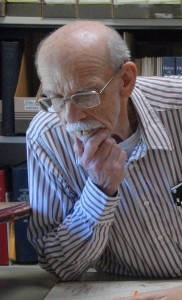 author of 14 novels, including six in his Sticks Hetrick crime series. He currently serves as librarian of his county historical society, where he assists patrons with genealogy and research.
author of 14 novels, including six in his Sticks Hetrick crime series. He currently serves as librarian of his county historical society, where he assists patrons with genealogy and research.
So he comes in contact with the public a lot and here is what they say. Take it away, John.
How did you come up with the idea for that story?
This is a question writers hear all the time. It surprises some people when we tell them the problem isn’t getting ideas, but finding opportunity to use them all.
Most people are constantly bombarded with creative seed-germs. Writers utilize their imagination to transform them into something to suit their purpose while others take them for granted and allow them to disappear into the ether.
There’s nothing magic about the process. Ideas, and their source material are all around us. A snatch of overheard conversation. The appearance or behavior of a particular person. An article in a newspaper or magazine. Any of these may spark an idea. Transformation begins when we ask, “what if…”
In my other life as a genealogist, I scour a lot of old newspapers and they have become a major source of ideas for me.
Our personal experience—the jobs we’ve had, the places we’ve visited, the people we’ve met over the years. All of these may inspire a springboard to a story idea.
As Joseph Conrad so aptly put it, “Only in men’s imagination does every truth find an effective and undeniable existence. Imagination, not invention, is the supreme master of art as of life.”
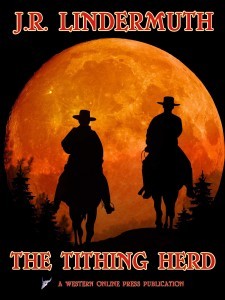 JIM: I just finished one of John’s books, Sooner than Gold. Excellent. And I will certainly get a copy of his latest and read it also. Here’s how you could go about it also.
JIM: I just finished one of John’s books, Sooner than Gold. Excellent. And I will certainly get a copy of his latest and read it also. Here’s how you could go about it also.
His latest novel, The Tithing Herd, a classic Western, was released on May 25 by The Western Online Press. It is now available at http://www.amazon.com/dp/B00XQK881Y
And both John and I would love to read your comment. Thanks.
May 22, 2015
Tasmania – more than just devils
Before we stepped off the plane in Hobart, all we knew about Tasmania was that the Tasmanian Devil made its home there.
Tasmania is located about 150 miles across the Bass Strait from Melbourne, Australia. To its west is the Indian Ocean and to its east is the Pacific Ocean. It is about 225 miles from north to south and generally about 190 miles from east to west, and has a population of just over half a million.
The British settled it in 1803 and in the first 50 years, over 75,000 convicts were transported to Taz. One of the first places we visited was Port Arthur, just 35 miles from Hobart, and site of one of the most famous prisons in Australia. 
 We then headed into the interior, a thinly populated, but gorgeous area. On one forty mile stretch, the residents hold a contest each year to see who can make the most interesting mail boxes. There were rocket ships, cartoon characters, tractors, animals – some quite large, other smaller, but every design interesting and different.
We then headed into the interior, a thinly populated, but gorgeous area. On one forty mile stretch, the residents hold a contest each year to see who can make the most interesting mail boxes. There were rocket ships, cartoon characters, tractors, animals – some quite large, other smaller, but every design interesting and different.
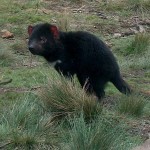 Beyond that, we found a preserve and research center for Tasmanian Devils. Here we were told about the Devils and why they are now listed as an endangered species. We were even allowed to pet one, but cautioned to keep our hands away from its head. They have extremely strong jaws and can easily crush the leg bone of a kangaroo. A finger would hardly be a challenge.
Beyond that, we found a preserve and research center for Tasmanian Devils. Here we were told about the Devils and why they are now listed as an endangered species. We were even allowed to pet one, but cautioned to keep our hands away from its head. They have extremely strong jaws and can easily crush the leg bone of a kangaroo. A finger would hardly be a challenge.
A relatively small island, Tasmania is the most mountainous state in Australia. Mount Ossa is over a mile high. These mountains spawn many rivers. While we viewed Taz as more like the U.S., say, sixty years ago, that does not describe their production of electricity. They generate all of their electricity needs by hydro plants on the rivers, and even sell a large amount of electricity to mainland Australia. One river supports seven generating plants before the water reaches the ocean.
Quite by accident, we came across “The Wall in the Wilderness.” Here, well-known Artist Greg Duncan is carving a stunning sculpture out of Huron pine. We found the  artist when we left the visitor’s gallery to explore a back room. He was working on another 3-D panel there and was gracious enough to visit with us and explain what he was attempting with this project. When finished, the sculpture will portray Tasmanian history from the indigenous people to pioneers, to lumber men, farmers, miners, and hydro workers. It will stand ten feet high and 300 feet long. At the time we visited, it was perhaps 150 feet long. In fact, he said he was going to have to stop the carving and extend his studio to accommodate the rest of the wall.
artist when we left the visitor’s gallery to explore a back room. He was working on another 3-D panel there and was gracious enough to visit with us and explain what he was attempting with this project. When finished, the sculpture will portray Tasmanian history from the indigenous people to pioneers, to lumber men, farmers, miners, and hydro workers. It will stand ten feet high and 300 feet long. At the time we visited, it was perhaps 150 feet long. In fact, he said he was going to have to stop the carving and extend his studio to accommodate the rest of the wall.
We made our way to Strahan on the west coast and made arrangements to take a float plane into the wilderness of the southwest part of Tasmania. Over one third of the entire island of Taxmania lies in reserves here, and there are no roads or settlements in this area.
Earlene and I and the pilot took off and circled out over large fish farms in the Indian Ocean. Then we headed in-land. It is truly a pristine wilderness, with inspiring, untouched forests, and the white water Franklin River. After awhile, we were tracking another magnificent river, cutting between mist-covered mountains and dense rain-forest. We began to descend into the thousand-foot deep Gordon River Gorge and slowly settled down on the river.
As the pilot taxied over to the bank, a small dock came into view. He hopped out and tied the plane up and we deplaned. A short walk through the rain-forest took us to a magnificent waterfall. The only noise was the falling water. No boom-boxes, no cars, no people. Enchanting. Eventually, we walked back to the dock, got in the plane, and the pilot – standing on the dock, untied the plane. The swift current quickly began to sweep the plane away from the dock. What we would do it the pilot didn’t manage to get in before we drifted away from the dock? Earlene could fly the plane, but could she take off from a rushing river? But, he managed to catch a strut, swing on to the pontoon and climb into the cockpit. Obviously, he’d done this before. It was a magical trip.
took us to a magnificent waterfall. The only noise was the falling water. No boom-boxes, no cars, no people. Enchanting. Eventually, we walked back to the dock, got in the plane, and the pilot – standing on the dock, untied the plane. The swift current quickly began to sweep the plane away from the dock. What we would do it the pilot didn’t manage to get in before we drifted away from the dock? Earlene could fly the plane, but could she take off from a rushing river? But, he managed to catch a strut, swing on to the pontoon and climb into the cockpit. Obviously, he’d done this before. It was a magical trip.
Our entire Tasmania visit was captivating. If you get to Australia, allot ample time for Tasmania. We spent a week there, and would have enjoyed a month.
Feel free to “share” or “like” this page. Thank you.
Over My Dead Body http://amzn.to/1BmYQ0Q
May 15, 2015
Abrv
We’ve gone through the Greatest Generation (as defined by Tom Brokaw), the Boomer Generation, Generation X, Generation Y, Millennials, Generation We, and others.
At this point, I think we’re in the Now Generation. And a growing trend is to abbreviate everything. Well, almost. Happy Hour seems to be growing rather than shrinking, ranging from two hours to six hours. I’m not including the places that say Happy Hour is Every Hour. Probably no place has a happy hour that is only one hour.
I see LOL often and don’t know whether that means Lot of Luck, Lots of Love, Laughing Out Loud, or Leave out Louie. Of course, it can be clarified by adding to it, as in LOL-ROF, which I am told means Laughing Out Loud – Rolling on Floor.
A biffie in the abbreviated world is App, which I am going to guess is short for Application. And there is an App for everything. If you can’t find an App for what needs to be done, you just haven’t looked enough. BTW (by the way), a California woman is suing her former company claiming she was fired for deleting an app from her phone, one the company had told her must be there 24/7 (24 hours a day, seven days a week).
Abbreviating comes in handy if you are txtng or Tweeting. Tweets limit you to 140 characters total for a message. As a result, neither of my sisters Tweet. But people love tweets. They are so “now.” And they can be used to convey every little detail of your day. But only in 140 character bites.
We do need a new dictionary, though, that defines all the abbreviations. OMDB could mean “Old Money Does Buy.” Or maybe, “On My Dedicated Blog.” Or Over My  Dead Body.” That’s the name of my book that released this week. It’s a contemporary mystery, or maybe a CM. Of course, CM could stand for Christian Mystery, and Over My Dead Body could be considered a Christian Mystery since the man who ultimately solves the crime is a minister.
Dead Body.” That’s the name of my book that released this week. It’s a contemporary mystery, or maybe a CM. Of course, CM could stand for Christian Mystery, and Over My Dead Body could be considered a Christian Mystery since the man who ultimately solves the crime is a minister.
I guess, in light of this trend to shorten things, I’ll just STI (stop this insanity).
(No need to type anything. Just click on “Like” and “Share” below. Or click on the cover to find out more about this new mystery.)
May 8, 2015
A Window into a Life
Today’s guest is Eileen Obser. She has been teaching creative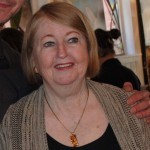 writing courses for twenty years. Her stories and personal essays have been published in a number of major newspapers and national magazines, including Newsday, and Ms. Magazine. Her memoir, Only You, covering her teenage years, was Published by Oak Tree Press last year. She lives and teaches on the east end of Long Island, in East Hampton, New York. Okay, Eileen. You’re on.
writing courses for twenty years. Her stories and personal essays have been published in a number of major newspapers and national magazines, including Newsday, and Ms. Magazine. Her memoir, Only You, covering her teenage years, was Published by Oak Tree Press last year. She lives and teaches on the east end of Long Island, in East Hampton, New York. Okay, Eileen. You’re on.
I am delighted to be Jim’s guest blogger this week and wish to write here about memoirs.
As a memoirist, and as a teacher of memoir and personal essay for over 20 years, I find so much pleasure in my work. My adult writing students, ages 18–90, constantly surprise me and often, themselves, at memories of the past that they can summon up during our workshops. Whether tapping into happy or unpleasant scenes from their childhoods or later on, sharing these reminisces brings them a great deal of satisfaction. Revealing traumatic experiences can often cause a calming effect or lead to a path of healing. I’m thinking now of powerful, well-known memoirs such as The Liar’s Club, The Glass Castle, and Angela’s Ashes, to name just a few, whose authors were able to rise above the sufferings of their youth.
Frank McCourt, in the famously quoted second paragraph of his book, writes, “When I look back on my childhood, I wonder how I survived at all.” Of his miserable Irish upbringing, we read, “You might be poor, your shoes might be broken, but your mind is a palace.” And, “It’s lovely to know the world can’t interfere with the inside of your head.”
While I encourage students to read these and many other memoirs, I don’t expect them to write whole books or best sellers. Nor do I push them to go down so deep into the tragic parts of their lives if it could cause them harm now, in the present.
My own memoir, Only You, set in my teenage years and encompassing,  really, the first 20 years of my life, was written over many years, starting when I was in my late 40s. I went as deeply as I felt comfortable, satisfying my need and desire to reveal myself, without exaggerating or exhibiting self-pity. Again, it was a slow process. As I grew older, the painful memories, along with the happy ones, became more understandable. I could be much more objective in relating them to the reader.
really, the first 20 years of my life, was written over many years, starting when I was in my late 40s. I went as deeply as I felt comfortable, satisfying my need and desire to reveal myself, without exaggerating or exhibiting self-pity. Again, it was a slow process. As I grew older, the painful memories, along with the happy ones, became more understandable. I could be much more objective in relating them to the reader.
I’m very pleased that my family, and friends from the teenage years, have read the book and complimented me for writing it, for capturing so many memories this way. Not one person faulted me for “overdoing” it, or for hurting anyone’s feelings with the story.
Certain students make me proud because they are indeed taking it slow and writing strong memoirs that they share in our workshops. “Keep going,” I tell them – we all tell them. Let us know more. And so they continue, fulfilling their needs to write and, at the same time, to communicate their life experiences with us, their readers and colleagues.
A quote from William Zinsser, the author of On Writing Well and Writing about Your Life, among other books: “Memoir isn’t the summary of a life; it’s a window into a life, very much like a photograph in its selective composition. It may look like a casual and even random calling up of bygone events. It’s not; it’s a deliberate construction.”
And from Anne Lamott (Bird by Bird and, most recently, Small Victories): “You own everything that happened to you. Tell your stories. If people wanted you to write warmly about them, they should have behaved better.”
What’s your story, I wonder? And have you started writing it?
Eileen’s website: www.eileenobser.com
Follow Eileen on Facebook
JIM: If you want to share a particular memory from your early life, feel free to put it in a comment. AND, don’t forget to “like” or “Share” this page. Thanks.
May 1, 2015
Keystone Pipeline Prompts a Book
Most people in the U.S. have heard about the Keystone Pipeline which could carry oil from Alberta, Canada to the Gulf Coast of Texas. It has made the news, and is still is a point of disagreement between Congress and the President.
As work proceeded on it across Texas, there were many protests. (I’ll talk about some of those at a later date.) These made the workers on the pipeline very anxious when strangers appeared.
The pipeline runs through part of our land (and I’ll talk about that another day  also). Once the court granted Keystone eminent domain, we gave up our fight and decided we would simply enjoy the process of such a large and complex project. The pipeline is roughly six hundred feet through the forest from our house, so it was easy for us to walk over and watch the progress.
also). Once the court granted Keystone eminent domain, we gave up our fight and decided we would simply enjoy the process of such a large and complex project. The pipeline is roughly six hundred feet through the forest from our house, so it was easy for us to walk over and watch the progress.
On one of my annual birthdays, my wife planned a large party. Throughout the day, people would wander down to see what this news-making pipeline was all about. Midway through the afternoon festivities, a couple came back and said the pipe was about to be lowered into the trench.
Within minutes, about thirty of our guests hiked over to watch. As our crowd emerged through the trees several hundred feet away from the pipe, all chatter among the workers stopped. Many just stared at us. Slowly, the foreman got the operation moving again.
 This was a massive steel pipe with walls more than a half-inch thick coated with green plastic. Ninety-foot sections had been welded together and lay perhaps six feet to the side of the ditch. Many large backhoes were trying to ease a quarter-mile section over and down into the seven foot deep trench.
This was a massive steel pipe with walls more than a half-inch thick coated with green plastic. Ninety-foot sections had been welded together and lay perhaps six feet to the side of the ditch. Many large backhoes were trying to ease a quarter-mile section over and down into the seven foot deep trench.
It was an amazing task. The pipe was too long to be handled all at once. So these machines slowly lowered the far end in and as each backhoe got the pipe it was handling into the ditch, the machine would then move to the head of the line to lift and move the pipe over the open trench.
Talk among the workers remained subdued and when time allowed, they would look in our direction, anxious to know what we were doing. Our group, on the other hand, whispered, not wanting to cause any distraction for those working on a dangerous task.
look in our direction, anxious to know what we were doing. Our group, on the other hand, whispered, not wanting to cause any distraction for those working on a dangerous task.
When the final backhoe got the last of the pipe safely and gently positioned in the trench, we all began to applaud.
We could see the frowns and worry lines on the pipeline workers immediately change to smiles. The foreman began to walk towards us, grinning. They now understood we were not there to protest, but to marvel at a difficult task well done.
Of course, the many protests, law suits, and opposition to the pipeline prompted me to write Over My Dead Body. In this mystery, Syd Cranzler objects to his land being seized for a private corporation by means of eminent domain. He tells the corporation representative his lawyer will file an appeal which, at the least, will delay the project for years. The next day, Syd is found dead from an overdose of his heart medication. The police rule it suicide. Case closed.
But Father Frank and another member of his church don’t believe Syd committed suicide and begin to look for evidence. And the more they find, the more their lives become in danger.
Real things in my life provided the genesis for my book. While I did not address the Keystone, it had jump started a book.
Click here to read more about Over My Dead Body.
April 26, 2015
Alone in Great Company
This week, we have the pleasure of hosting D.R. Ransdell.  She loves to travel, has taught in Mexico and the U.S., and also writes great mysteries, often with a little mariachi flavor to them. She will give away a copy of Island Casualty to someone who comments. I’m going to leave a comment – I know how good her books are. Welcome, D.R. Ransdell.
She loves to travel, has taught in Mexico and the U.S., and also writes great mysteries, often with a little mariachi flavor to them. She will give away a copy of Island Casualty to someone who comments. I’m going to leave a comment – I know how good her books are. Welcome, D.R. Ransdell.
Although serious writing requires hours of isolation, it ironically also provides great opportunities for people to come together. A fine example of this was the recent Tucson Festival of Books held in March on the University of Arizona Campus. Specifically, my own moments of coming together mostly happened at the Oak Tree Press booth.
Publisher Billie Johnson was kind enough to drive down from California for the weekend to be on hand to display our books. Those of us from Tucson or nearby spent time in the booth interacting with potential book buyers as well as one another. Names I only knew through email turned into real people.
W hile Carolyn Niethammer and I live in Tucson, Janet Greger, Virgil Alexander, Bob Richter, and Amy Bennett all drove to town and helped us with the booth. While we didn’t sell books left and right, we sold some books and distributed LOTS of information. We had the opportunity to be out in a huge crowd and have our titles displayed with other books from Oak Tree Press. Many times browsers stopped at the book carousel and viewed our titles. While we would have been more thrilled if they had all bought lots of books, we recognized the importance of name recognition. Don’t marketing experts say that it takes seven instances of viewing a product before a customer decides to buy it?
hile Carolyn Niethammer and I live in Tucson, Janet Greger, Virgil Alexander, Bob Richter, and Amy Bennett all drove to town and helped us with the booth. While we didn’t sell books left and right, we sold some books and distributed LOTS of information. We had the opportunity to be out in a huge crowd and have our titles displayed with other books from Oak Tree Press. Many times browsers stopped at the book carousel and viewed our titles. While we would have been more thrilled if they had all bought lots of books, we recognized the importance of name recognition. Don’t marketing experts say that it takes seven instances of viewing a product before a customer decides to buy it?
Carolyn even had a dinner for her fellow authors; naturally the one night I really wanted off, I had to go play a gig! But I thoroughly enjoyed having a chance to find out more about Bob’s travels and Amy’s experiences in New Mexico. Several of us swapped books for the all-too-elusive review.
We also had the chance to talk “book,” We shared our frustrations about marketing and our love of putting words to paper and seeing our characters come alive. We were tickled by the fact that we’re all very different, and yet we have a shared common purpose to entertain and sometimes enlighten the world at large. It’s humbling to be part of such a rich cultural project even if we’re only tiny specks on the spectrum.
Best of all, we had the chance to talk at length with Billie.  Good heavens—she’s even busier than we are! She told stories of getting started with her company. She shared marketing strategies and knowledge accumulated through her vast experiences in the business. She was also grace under fire; many, many potential authors wanted to talk to her. Some had looney ideas about how they’d written the best book ever (or in one case, I think it was her seven-year-old daughter; I stayed as far away as possible). In each case Billie listened patiently. Usually she invited the authors to send something via the website—I wonder how many managed it!
Good heavens—she’s even busier than we are! She told stories of getting started with her company. She shared marketing strategies and knowledge accumulated through her vast experiences in the business. She was also grace under fire; many, many potential authors wanted to talk to her. Some had looney ideas about how they’d written the best book ever (or in one case, I think it was her seven-year-old daughter; I stayed as far away as possible). In each case Billie listened patiently. Usually she invited the authors to send something via the website—I wonder how many managed it!
By now the book festival is behind us for another year, but I’m already looking forward to the next one. I hope Oak Tree will have a booth again. At the very least, I hope to meet up with the other authors who live nearby. I may write alone, but it’s wonderful to have the chance to share all our experiences. Then we can all go home and write about them!
To read about my murder mystery series featuring mariachi violinist Andy Veracruz, please check out http://www.drransdellnovels.com
To find out about Oak Tree Press: http://www.oaktreebooks.com/
To find out about the Tucson Festival of Books: http://tucsonfestivalofbooks.org/
Leave a comment for a chance to win one of her mysteries.



